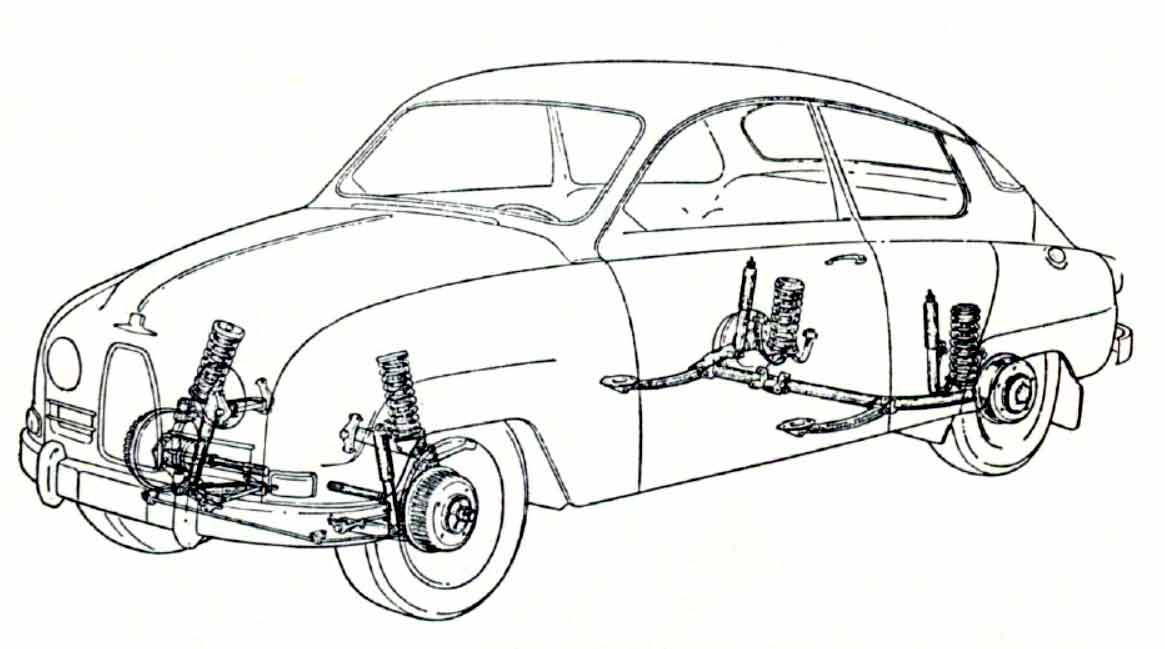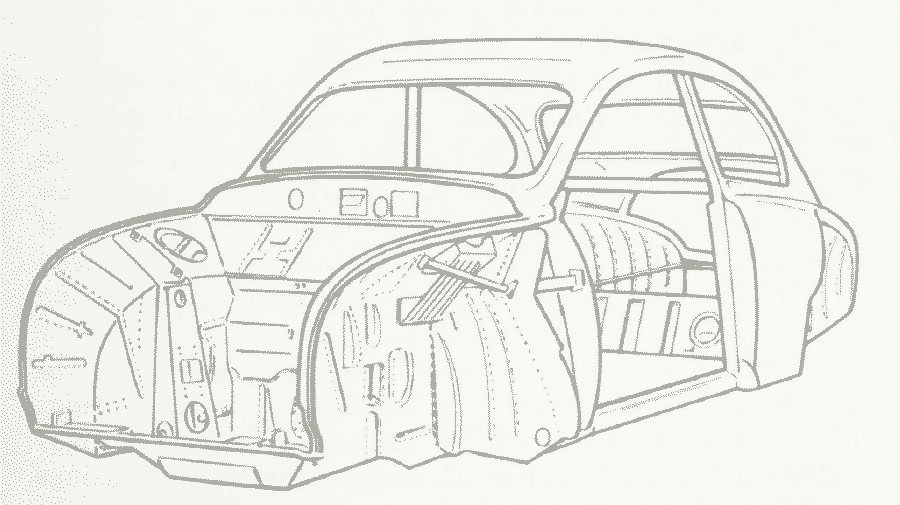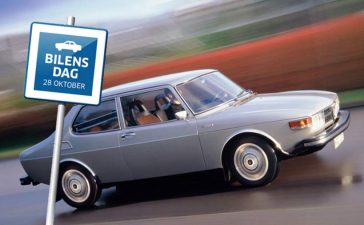The roots of Car Safety go back to the very beginning of the production of “wingless aircraft”, all due to the fact that the first Saab cars were created by aeronautical engineers all due to the fact that the first Saab cars were created by aeronautical engineers who put safety first.
Table of Contents
The SAAB had to be practically uncrushable
When the management of SAAB decided to go into the automobile business back in 1946, they laid down the basic principle that the car was not only to be an ultra-safe car for the occupants, but also for the pedestrian. It had to have the best possible braking system, it had to be skid-proof, sure-footed enough for safe cornering on icy and gritty roads, simple enough for the ownerdriver to maintain.
In addition, the interior was to be roomy enough to provide comfortable seating for four average-sized people who were to ride protected by the highest possible factor of safety. In other words, the shell of the SAAB had to be practically uncrushable.
First Safety features in Saab Cars
The design of the little car was placed in the hands of Gunnar Ljungstrom, the SAAB chief designer, who dedicated himself to these safety principles. That is why SAAB had a foam rubber padded dash, a collapsible steering wheel and safety sun visors, together with a number of ingenious safety devices which we shall detail later. Prior to 1961, SAAB fitted a thin metal collapsible dash.
The SAAB design engineers started from scratch. First they made a clay model of what they wanted their automobile to look like, and then they went to work on the many complicated problems of bringing their conception to reality.
Most serious among their problems was the necessity for maintaining absolute rigidity in the steel welded shell, and at the same time providing adequate doors and windows. After all, a sightless or “over-blind-spotted” car would present a more serious safety hazard than any weakening of the structure due to windows.
Strengthening the Car Structure
After reinforcing the side windows to their satisfaction with steel stiffening frames, there was still the problem of the rear window – which in the early SAAB was on the small side. This was finally su surrounded by a steel frame welded to the shell, which itself is a continuous unit from the rear of the car up to the doors.
This part of the body resembles an eggshell from which a large part of one end has been streamlined. This shell form is prevented from deformation by inserting a bulkhead or bottom a short distance inside the shell, to prod uce a considerable stiffeni ng effect. This bulkhead consists of the sloping wall which serves simultaneously as the back support of the rear seats. Although there is a large aperature in this wall to allow access to the luggage compartment, the wide surface of the plates on three sides enables the wall to function stress-wise as if it were solid.
The roof is rigidly fixed at the top, the floor at the bottom, and the outer panelling of the body at the sides. The sides of the floor are strengthened with straight closed-plate sections. Thus the roof and flooring extend towards the front, forming two strong beams wihch are fixed at the back of the shell. The fire wall is located between the front end of these beams. where the frame for the windshield is mounted.

The fire wall has extra strong lateral side members to allow it to take vertical loads, the fire wall itself forming a channel girder across the entire car over two feet in height. The wheel housings which are located near his “massively” strong channel girder form the side walls of the engine compartment and constitute a supporting member for the front of the car, with the flooring connecting them.
The main part of the spring-suspended weight of the car (body plus passengers) is transmitted to the springs through the shortest possible path; the front and rear spring suspension consists of arms mounted in housings directly bolted in front of the fire wall and behind the sloping wall referred to above.
The dimensions and layout have been chosen so that all parts cooperate in taking the maximum permissible stress at maximum loads. Loading tests carried out under realistic conditions verified this, the strain gauges showing thai minimum deformation was experienced despite the openings for windows and doors which worried the SAAB aeronauticul designers considerably.
3 years of research and development
When he settled down to design the SAAB 92, which was the first car put out by SAAB after three years of research and development, Gunnar Ljungstrom also had to shoot for the highest possible economy combined with satisfactory performance.
As far as is known, few limitations were placed on the design department. SAAB wanted to build a car, and it had to meet certain definite specifications, just as would a new aircraft. Choice of engine, transmission and general layout was left to Ljungstrom.
Cars ideal for winter conditions
One can well imagine that the aircraft designers had a lot of fun, combined with a tremendous amount of painstaking research. A great many factors had to be considered. First, of course, the car had to be able to perform well in Sweden’s winter climate. An engine that started poorly in cold and damp weather was out of question, as was a car that tended to go into a skid at the first sign of ice. Also, the body of the car had to provide adequate protection for its riders against extreme cold and heat.
Simplicity is essential
SAAB selected a 2-cycle engine because of its inherent simplicity, its starting ability under all weather conditions and its beneficial quality of being self-lubricating. The early SAABs (Series 92) were equipped with a 2- cylinder, 2-cycle water cooled engine employing the Schnurle principle.
In the SAAB 93, which made its appearance in 1955, this engine was replaced by a 3-cylinder model. This small power unit is in itself a tribute to engineering ingenuity, achieving a considerably higher output by increasing the number of cylinder to three without increasing the total cubic capacity.
No one being better qualified to describe an engine than its designer, let’s hear from Gunnar Ljungstrom by means of extracts from a technical paper he wrote in 1955 prior to the introduction of the SAAB 93 in Sweden and the U.S.: “The cylinder block and the upper part of the crank case with half the bearing seats for the crankshaft are cast in one piece. The lower half of the crankcase contains the main bearing caps. These two parts are of cast iron. The cylinder head is an aluminum alloy.”
“The crankshaft is straightforward and rugged in design. It consists of six identical disks interconnected by main and big-end bearing pins. All constituent parts are case-or-induction-hardened. The crankshaft is carried in four similar SKF single-row ball bearings, which all satisfy stringent requirements on radial play and tolerances on outside and inside diameters. All main bearing seats are made to tolerances as close as .0006 in. – another example of the high precision built into this engine.”
“The use of crankcase compression to scavenge the engine requires efficient sealing between the crankcases of the three cylinders. This is ensured by labyrinth seals consisting of ordinary piston rings fitted in their grooves with small clearance and pressing outwards. The distributor drive is sealed off by spring-loaded rubber seals. The three big-end bearings are designed as double-row cylindrical roller bearings, with the rollers directly contacting the hardened surface of the big-end pins and connecting rods. The roller cages are die cast in one piece. The simple construction of the crankshaft, the direct journalling of the main bearings in the cast-iron seats and the direct contact of the big-end bearing rollers with the big-end pins and connecting rods have kept the number of tolerances to a minimum. This in turn has made it possible to keep all bearing play within the narrow limits required for quiet running without having to resort to a comprehensive selection system.”
Cooling-system Design
“The ignition system is of conventional automobile type with 12-volt primary voltage, differing only in that distributor r.p.m. is the same as crankshaft r.p.m., which is not the case in 4-stroke engines. The cooling system includes fan, thermostat and a circulating pump with rotor attached to the extended generator shaft. Generator and fan are driven by a common V-belt. The radiator is positioned immediately behind and higher than the engine so that the fan forces air through it. Cooling-system capacity is sufficient for continuous city driving in the hottest weather and has also proved satisfactory for driving over the steepest alpine passes. Our decision to use water cooling instead of air cooling was greatly influenced by the wish to provide a really effective heating system for the car; with water cooling the heat can be carried in small size hoses from the heat-producing engine to the most suitable point for warming up the ventilation air. In direct air-cooling system, the air has to flow over engine parts which are often dirty, oily, etc.; the ventilation air is also liable to pollution from defective gaskets and similar.
Quick heating-up of the coolant is assisted by a thermostat which shuts off the flow of water to the radiator during the warming up period and directs the entire quantity through the heat exchanger for ventilation air. The heat exchanger is situated forward of the instrument panel and immediately in front of and under the fresh-air intake at the lower edge of the windshield. Fresh air thus has only a short distance to pass through the heat exchanger and into the car…”












Imagine how cool it would be if we could order NEW vintage and classic SAAB body shells from Dynacorn.
“SAAB – until you can afford a car!”
Strongest body ever built!
Loved these cars!